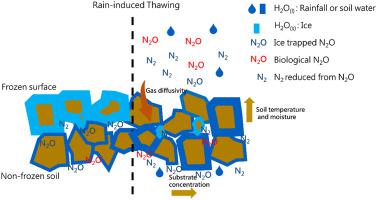Soil Biology and Biochemistry ( IF 9.7 ) Pub Date : 2020-08-15 , DOI: 10.1016/j.soilbio.2020.107960 Chih-Yu Hung , Joann K. Whalen

|
In cold temperate humid regions, peak nitrous oxide (N2O) fluxes coincide with spring snowmelt. However, other extreme climatic events in the non-growing season, such as rainfall that causes temporary thawing at the bare soil surface without snow cover, could be responsible for appreciable fluxes of N2O. The objective of this study was to quantify the proportion of ice-trapped N2O and biologically-produced N2O released following a rain-induced thawing event on soils collected in late fall. The lab experiment was done in soil-filled microcosms after the soil surface was frozen at −20 °C for 2 h, which generated a 1–2 cm ice layer at the soil surface, before they were injected with N2, N2O and 15N2O gas at 5 cm depth and then received different amounts of water with customized rainfall simulators (0, 3, 7.5 or 15 mm simulated rainfall h−1) at 4 °C. Gas samples were collected at 2, 6, 12, 24, 48 and 96 h after gas injection. Soil temperature and water content increased faster after rain-induced thawing than after the air-induced thawing event. The release of ice-trapped N2O was not affected by rain-induced thawing because soil pores filled with melted ice-water, which slowed N2O diffusion and reduced N2O to nitrogen gas (N2), based on the production of 15N–N2. However, high simulated rainfall intensity (7.5 and 15 mm h−1) contributed to greater biological N2O emission after 48 h. We conclude that rainfall on a frozen bare soil surface in cold temperate humid regions may cause N loss through harmless N2, rather than the greenhouse gas N2O.
中文翻译:

模拟降雨对降雨诱导的冻土微观解冻后一氧化二氮排放的生物物理控制
在寒冷的温带潮湿地区,一氧化二氮(N 2 O)峰值通量与春季融雪重合。但是,在非生长季节的其他极端气候事件,例如降雨会导致裸露的土壤表面暂时融化而没有积雪,可能是造成N 2 O通量显着增加的原因。本研究的目的是量化比例在深秋收集的土壤中,雨水引起的融化事件后,冰夹带的N 2 O和生物产生的N 2 O释放。在将土壤表面在-20°C下冷冻2 h,然后在注入N 2,N 2之前,在土壤充填的微观世界中进行了实验室实验,这在土壤表面产生了1-2 cm的冰层。O和15 N 2 O气体在5厘米深度处,然后在4°C下使用定制的降雨模拟器(0、3、7.5或15毫米模拟降雨h -1)接收不同量的水。气体注入后的2、6、12、24、48和96小时收集气体样品。降雨引起的融化之后,土壤温度和水分的增加要快于空气引起的融化事件之后。被土壤融化的土壤孔隙充满了融化的冰水,从而降低了N 2 O的扩散并减少了N 2 O转化为氮气(N 2)的量,因此降雨引起的融化不会影响冰层中N 2 O的释放。的15 N–N 2。但是,高的模拟降雨强度(7.5和15 mm h -1)有助于在48 h后产生更大的生物N 2 O排放。我们得出的结论是,寒冷温带湿润地区的裸露的冰冻土壤表面上的降雨可能会通过无害的N 2而不是温室气体N 2 O导致N损失。



























 京公网安备 11010802027423号
京公网安备 11010802027423号